Ron Eller identifies two versions of Appalachia: a real place and an imagined region. He makes this distinction because he has dedicated his career in higher education to addressing the needs of rural communities. Transcending the boundaries of the classroom and library, Eller’s research in Appalachian history and culture is motivated by his desire to help people understand Appalachia.
 “Although I have written extensively about Appalachian identity and the challenges that stereotypes and images about Appalachia pose to the region, what’s most meaningful to me is the task of developing education and knowledge to make a better future for Appalachia,” said Eller.
“Although I have written extensively about Appalachian identity and the challenges that stereotypes and images about Appalachia pose to the region, what’s most meaningful to me is the task of developing education and knowledge to make a better future for Appalachia,” said Eller.
A first-generation college graduate, native Appalachian and Professor of History at UK, Eller prefers to consider himself not as academe’s preeminent authority on Appalachian Studies, but instead as a public intellectual who strives to improve the life in Appalachia and expose the economic and social inequality that has crippled his home region for centuries. To that end, he writes for a public audience, and appears in a wide variety of media outlets, including Diane Sawyer’s 20/20 special “A Hidden America: Children of the Mountains.”
Casual observers might be surprised by Eller’s suggestion that Appalachia is an idea created by nineteenth century journalists who wrote for publications in urban areas of the United States. Nevertheless, Eller has long argued that historians and cultural critics should differentiate between a real and imagined Appalachia so they can understand how the region has developed socially and economically.
“The idea of Appalachia has played a major role in how public policies have been established over time,” Eller explained. “Appalachia has always been a foil for how urban Americans want to define society and culture. It allows those who view urban life as a positive outcome of America’s scientific and technological progress to represent Appalachia as backward and unsophisticated. On the other hand, for those people who don’t like urban life, Appalachia is rural bliss, something to be preserved and valued for its rusticity.”
Eller extends these ideas in his most recent contribution to Appalachian Studies, “Uneven Ground: Appalachia Since 1945,” a book that was published last year by the University Press of Kentucky, and has already won the 2009 V.O. Key Award from theSouthern Political Science Association for the best book in Southern Politics. Eller suggests that Appalachia, far from being merely an idealized counterpoint to mainstream America, is in fact a microcosm of it, a window to our understanding of how we relate to the environment as a nation and a model of the uneven economic conditions that constitute and produce the collective American society.
 “The title of my book, “Uneven Ground,” has a dual meaning,” Eller said. “Those of us who are from the mountains refer to our place as uneven ground. Our community exists in a place where the land isn’t even, and that rugged terrain informs and creates many positive cultural aspects that come with mountain life.”
“The title of my book, “Uneven Ground,” has a dual meaning,” Eller said. “Those of us who are from the mountains refer to our place as uneven ground. Our community exists in a place where the land isn’t even, and that rugged terrain informs and creates many positive cultural aspects that come with mountain life.”
By speaking of uneven ground as a quality of Appalachian towns, Eller also intends to describe places that experience massive social and economic inequalities. Appalachia has lagged behind the rest of the United States in health, income and environmental stability. Indeed, much of the uneven distribution of wealth throughout the United States can be traced back to the way Appalachia has been imagined.
“Appalachia, because of the way that it has been mythologized, is a place where we see flagrant injustice to land and people,” said Eller. “It’s a representation of how we’ve chosen to develop society and how we’ve chosen to interact with the natural world around us.”
However, as Eller explains his work, he is quick to point out that Appalachia is not just an idea—it’s a real place with unique societies and irreplaceable musical, literary, and religious traditions. These realities, especially the actual hardships that the people of Appalachia endure, compel Eller to reflect on the relationship between his academic research and his civic engagement.
“Public universities in particular have a special responsibility to transfer knowledge and critical thinking skills we have to the community,” Eller said. “We are not engaged in just teaching 18-22 year-olds within the confines of a classroom. We have a responsibility, in my case as a historian, to help as many people as possible to learn from our past and then make decisions about how we’ll handle our future.”
By Andrew Battista
Photos by Mark Cornelison
